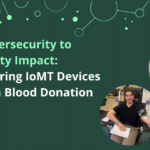How to Solve the Fastest Growing Attack Surface with IoT Patching

Internet of Things (IoT) devices have become integrated into every facet of technology and modern life. In addition to consumer-facing connected devices—smart TVs, watches, thermostats, and more—IoT devices have proven instrumental in improving efficiency and data-driven decision-making across multiple industries.
While estimates for the exact global number of IoT devices vary, it remains clear that IoT devices have experienced explosive growth over the last several years. The National Institute of Standards and Technology (NIST) estimates over 75 billion IoT devices will be in use by 2025; that’s nearly 10 devices for every person on Earth.
As a result, IoT devices are the fastest-growing attack surface that organizations must manage and secure against cyber threats. However, securing connected devices is often challenging, and many security controls and tools that work for traditional endpoints are insufficient to mitigate risk for IoT devices.
How IoT Device Sprawl Creates an Expanded Attack Surface
One of modern security teams’ most significant challenges is managing their attack surface. Everything from APIs to web servers is a potential entry point for malicious actors, and IoT devices only expand an organization’s attack surface.
More Devices, More Risks
Yet, despite the risks, the convenience and value of connected devices lead organizations of all sizes and across all industries to continue to implement them. According to research, as of 2022, enterprises deployed over 100 million IoT devices, which has undoubtedly skyrocketed since then.
For example, manufacturers rely on connected devices to enable real-time monitoring, automation, and predictive maintenance. As a result, manufacturing has a higher rate of IoT adoption than other industries, with an average of 47 IoT devices per thousand square feet of factory space.
Exploitable at Scale: How a Vulnerable Device Can Compromise Entire Networks
As with traditional IT devices, IoT devices can have critical vulnerabilities, leaving them at risk of exploitation. However, because many IoT devices use outdated processors and operating systems, they cannot leverage modern attack-mitigation features.
Over the last several years, critical vulnerabilities have surged at an astounding rate. A pre-pandemic study analyzing vulnerabilities in IoT devices found that, in 2019, there were 1,342 IoT device vulnerabilities, accounting for 11% of the total vulnerabilities identified that year. As the number of critical vulnerabilities disclosed has continued to rise—hitting 40,000 last year—so has the number of vulnerable IoT devices. Data shows that among Internet of Medical Things (IoMT) devices, there is an average of 6.2 vulnerabilities per connected medical device.
For industries that provide critical services like manufacturing and healthcare, leaving IoT devices at risk can impact the security of the entire network, potentially leading to downtime or other adverse operational impacts. Further compounding the problem, IoT device patching is difficult to manage.
The Challenge of Vulnerability Management and IoT Device Sprawl
With more devices comes a higher chance of vulnerabilities, yet conventional methods of scanning and patching don’t necessarily work for connected devices. The challenge of patching IoT devices is twofold: patches may not be available, and it’s complicated to patch connected devices.
Many IoT devices lack a traditional user interface, which makes patching slow, and many connected devices are part of critical processes, making organizations reluctant to take them offline to patch. For example, an automobile manufacturer that uses smart sensors on its assembly line likely has the sensors handle multiple functions, from monitoring performance to adjusting production speed. If they have a large factory, they could have as many as 4,700 connected devices or more. The manufacturer would likely need to cease production to patch the sensors, reducing productivity and potentially creating downstream impacts for the supply chain. It’s easy to imagine how much longer it would take the manufacturer to patch all their connected devices—if they even try.
Attackers Move Fast—Your Defense Needs to Move Faster
Vulnerability management is challenging enough for traditional IT devices. In 2024, it took organizations an average of 97 days to patch critical vulnerabilities. Many organizations struggle with the ambiguity surrounding the patch process: which team is responsible for patching, security or IT, and do they have the necessary resources to roll out patches and continue with their regular tasks?
Cybercriminals are cunning and fast-acting; they exploit patch hesitancy and scour the internet for vulnerable devices to target. In 2023, the average time to exploit a vulnerability was five days, meaning most organizations patch too late. Once malicious actors have compromised a vulnerable connected device, they can move laterally to access other critical systems and present a risk to the broader network.
Patching at Scale: How an IoT Security Platform Streamlines Vulnerability Management
As organizations continue to expand their IoT device fleet, they need to develop a robust, repeatable process for patching and updating connected devices. The answer lies in leveraging a purpose-built IoT security platform to monitor and mitigate device risk across the entire IoT device fleet, including critical vulnerabilities. An IoT security platform can help organizations streamline the patch process, mitigating risk at the device level and reducing the burden on internal teams.
Typically, patches and updates require planned downtime. An IoT security platform can automate the deployment process, supporting on-demand updates for individual devices or scheduling bulk updates to minimize disruptions in devices that are part of critical workflows or processes. That means the hypothetical manufacturer above can plan a bulk update for all 4,700 connected devices without disrupting critical processes.
As an added benefit, when organizations take steps to secure their IoT device fleet, they reduce their exploitable attack surface, mitigating the risk of a disruptive cyber attack.
How Asimily IoT Device Patching Helps Organizations Manage Their Attack Surface
Undoubtedly, organizations will continue to add IoT devices to their network, and as they continue to expand their attack surfaces, they will need to take proactive risk mitigation steps. Patching IoT vulnerabilities is one of the most important things teams can do to reduce the risk of a breach occurring because of a connected device.
The Asimily platform has long been purpose-built for connected device security. Asimily builds and maintains a complex inventory of devices, monitoring device behavior for anomalies, and simplifies the process of applying patches and updates, all within one unified platform. And now, Asimily allows organizations to scale their risk mitigation with IoT patching —available in just a few clicks.
Asimily’s IoT Patching solution helps organizations automate the patching and update process, reducing the risk of IoT-related security incidents and maintaining the integrity of their IoT ecosystem. This feature reduces the time and uncertainty teams face with regard to IoT patching, presenting them with a clear, unified view of device risk across the entire attack surface.
To learn more about Asimily and the IoT patch management functionality, reach out now to book a demo.
Secure Every IoT Device.
Automatically.
Cyber threats move fast — so should you. Asimily gives instant inventory and smart, prioritized risk mitigation insights for every IoT, OT, and IoMT device — so you can take action before threats strike.




